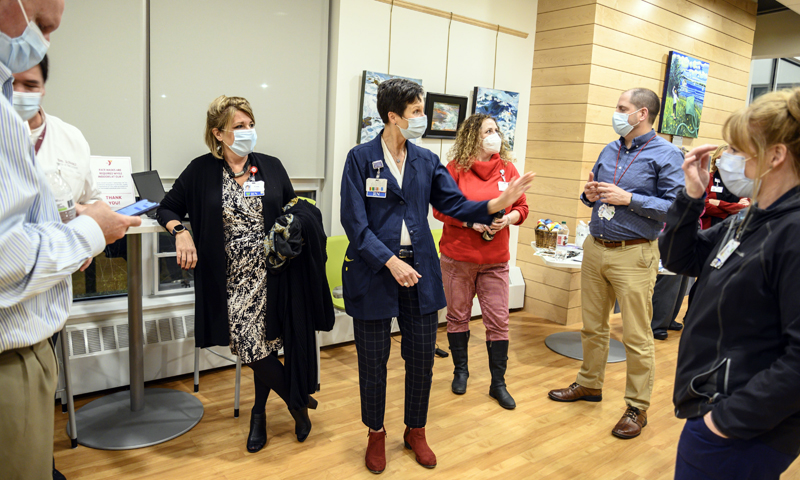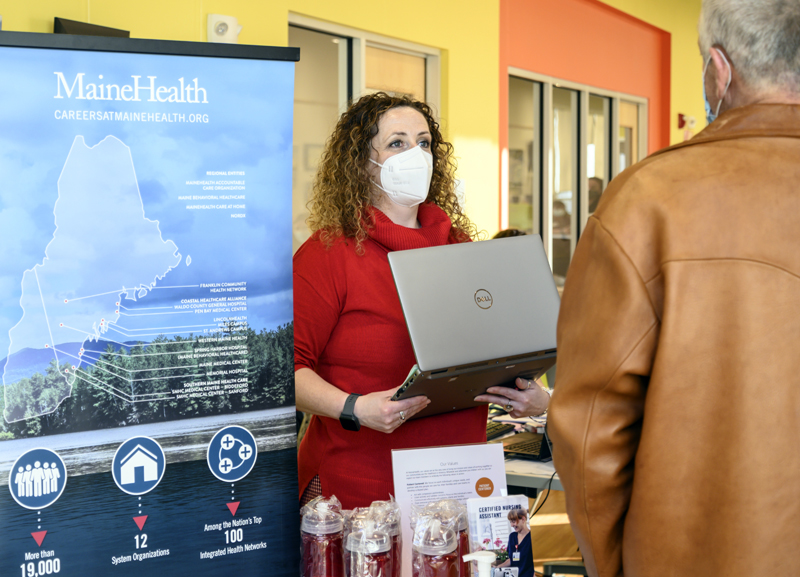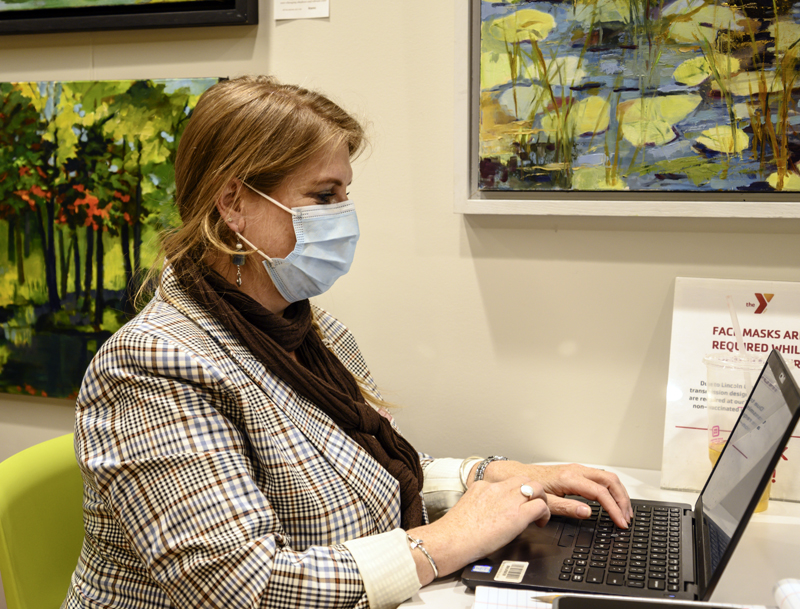
Cindy Wade, third from left, president of LincolnHealth, observes as department heads and staff share their excitement about the success of a job fair at the Central Lincoln County YMCA in Damariscotta on Nov. 16. (Bisi Cameron Yee photo)
Two of Lincoln County’s largest healthcare employers face stiff challenges when it comes to fielding enough staff to attend to the medical needs of county residents.
But both are solution-focused. And both are starting to make inroads in a crisis of care that existed prior to the pandemic and is exacerbated by it.
Cindy Wade, president of LincolnHealth, said the organization had 77 full-time, part-time, and per diem positions open in Lincoln County in July. In November, that number more than doubled to 162 openings.
While the workforce shortage existed before the October vaccine deadline, John Martins, director of communications and public affairs at LincolnHealth, said the system lost a few people to the mandate. But according to Martins, department heads were proactive in talking to those who might leave, and as a result, they were able to hire replacements in time to stave off the brunt of that challenge.
Still, positions are taking longer to fill. In a July 29 phone interview, Wade said “…we have gotten pretty creative. We have to be open 24/7 – that becomes way more challenging when … staffing is limited.”
Wade said there were times the hospital had to limit admissions because it “did not have the right number of staff to provide the high level of care that we stand by.”
Wade said that LincolnHealth’s Human Resources Department had some success in hiring but there are positions that have remained unfilled for a year or longer, particularly nursing positions in the long-term care facility.
Nursing positions are particularly challenging to fill due to a national shortage stemming from years of shrinking graduation rates at nursing schools, according to Wade. Qualified instructors are more and more difficult to source as competition for skilled practitioners continues to grow.
The pandemic brought additional challenges. Wade said a lot of people were fearful. They did not want to contract the virus or they did not want to risk bringing it home to loved ones. A number of employees “self-selected” out of their roles.
Schools going remote along with decreased day care accessibility were another major factor.
“People have to take care of their kids,” Wade said. But hands-on clinical professionals don’t have the option to work remotely. More qualified individuals left the field.
“We’ve had some silver linings with COVID,” Wade said. “We’ve been able to expand telehealth pretty quickly.”
In addition, moving staff members who weren’t patient-facing like clerical, billing and finance staff to remote work “supported their need to be home and our need to not have them in the building.”
The fact that the Miles Campus was not overwhelmed with COVID patients helped minimize the risk of burnout that has been was a driver of resignations at larger hospitals. While the current shortage of hospital beds has necessitated keeping some patients on site, historically most COVID patients were transferred to the Maine Medical Center in Portland.
Wade said harnessing the flexibility of employees was another win. The obstetrics unit at Miles stepped up during COVID. Staff from the unit pitched in where needed and when the department was empty, the additional beds became another resource.

Andrea Nakamura, far left, talks to Kyle Winchenbach, center, about the pharmacy department during a LincolnHealth job fair at the Central Lincoln County YMCA in Damariscotta on Nov. 16. (Bisi Cameron Yee photo)
As the pandemic progressed and vaccination clinics began to open, LincolnHealth was faced with another strain on staffing. But people pivoted when it was needed. They transitioned into different roles, worked in multiple departments and even multiple clinics rather than just remaining in previously prescribed roles.
Once LincolnHealth was able to open its doors to volunteers again, it got a little easier, Wade said.
“Volunteers are part of the backbone of care we provide here. They are instrumental in places like COVID clinics where they could help meet, greet and observe patients,” Wade said.
Wade said LincolnHealth saw a turnover rate of 11.34% for the rolling 12 months ending in June with a retirement rate of 5.81% for nurses, which Wade said is “actually pretty good.”
LincolnHealth rolled out a new compensation model in August, raising the base rate of pay from $14 to $17 and shifting pay for the rest of the organization to avoid salary compression.
Wade said the hope is that the adjustments will tell existing staff they are appreciated and will aid in recruiting new employees.
LincolnHealth is working with nursing schools to try to rebuild that critical sector of their workforce. The organization partnered with Central Maine Community College to provide clinical opportunities for 12 nursing students this year.
“We’re trying to grow our own and partner with others to provide more access to schooling,” Wade said.
They also fund a program that pays employees to take certified nursing assistant classes to become promotable to those key positions.
LincolnHealth does make use of sign-on bonuses, especially for the more difficult to fill positions. They pay relocation expenses, although Wade said relocation brings up another challenging issue in the county: The lack of affordable housing.
High school outreach is one of the most important recruitment programs. “Kids in our community have no idea about the job opportunities here,” Wade said. Nor about the additional benefits such as scholarships, tuition reimbursement, and free classes that are available.

Nickolas and Marli Rollo attend a LincolnHealth job fair at the Central Lincoln County YMCA in Damariscotta on Nov. 16. Nickolas Rollo said he was interested in a part-time position in the hospital kitchen to supplement his income. (Bisi Cameron Yee photo)
“It’s about connecting people that live here to opportunities,” Wade said, and about combating the migration of young workers to out of state opportunities.
LincolnHealth is utilizing every possible avenue to recruit staff. Social media posts for key jobs are updated every Wednesday. Ads are run in local papers. And On Nov. 16, LincolnHealth partnered with the Central Lincoln County YMCA for their first in-person job fair since the advent of COVID-19.
Jennifer Kopp, a senior talent acquisition partner at MaineHealth, said the turnout was better than expected. Applicants were able to meet directly with hiring managers, and some received conditional offers on the spot.
Kopp said the job fair brought out new job seekers, but also a good number of people looking to transition to better jobs.
Kelly Creamer, director of wellness and rehabilitation, said she knew there was a projected nursing shortage but she didn’t anticipate it being this significant. She mentioned competition with high paying traveling companies as yet another factor in the difficulty of finding qualified candidates.
Department heads had specific qualities in mind as they interviewed candidates: The ability to handle stress and conflict, commitment to quality and teamwork, and, tellingly, understanding pandemic requirements including masking and distancing protocols and the necessity of being vaccinated.
Martins, who was on hand at the job fair, said, “even filling a handful of positions would help tremendously.”
“Staffing is always a challenge,” Wade said. Add the COVID factor to the childcare problem and the tight housing market “and you have a perfect storm.”
But there is one particularly important benefit to becoming a healthcare worker, according to Wade.
“It gives back to the community and also gives to you. There is nothing more rewarding than being able to help somebody feel better. Come to healthcare and take care of your friends, your family, your neighbors, and each other. That’s really what it’s about.”
Lorrie Winslow, chief executive officer at the Lincoln Home in Newcastle, said the almost 100-year-old institution is, like so many other places, looking for new employees. But the Lincoln Home and its memory care unit, Harbor View Cottage, are fortunate to have only five positions to fill on a staff of approximately 100.

Sarah Evan greets a potential LincolnHealth employee during a job fair at the Central Lincoln County YMCA in Damariscotta on Nov. 16. (Bisi Cameron Yee photo)
“So in the grand scheme of things, we are not understaffed,” Winslow said. “Do we have challenges? Absolutely. Always.”
The Lincoln Home already has the two full-time nurses and one per diem nurse needed to manage the immediate medical needs of residents. They are looking for two CNAs and two additional employees to fill out their dining and maintenance staff.
Winslow said the board of the assisted living facility focused first on honoring existing staff, rewarding them for their service with “gratitude bonuses” and ensuring that their wages make sense and allow them to live comfortably.
In addition, mandated overnights and extra shifts are not part of the staffing model at the Lincoln Home. The facility relies on a large contingent of part-time workers for a flexible schedule that ensures all necessary shifts are covered.
Both the board and Winslow are committed to their long-term employees. And they have a few – staff and residents recently celebrated the 40th anniversary of one employee.
That celebration underscored the importance of maintaining the consistent presence their residents rely on.
But COVID has been a big challenge, Winslow said. They lost some people. But they also lost people to higher paying jobs both inside and outside the field of healthcare, including some who made the shift to LincolnHealth when the hospital increased its base rate of pay in August.
“It’s a double whammy,” Winslow said. “Care staff has been an issue in Maine prior to COVID. But now because of COVID it’s become a crisis.”
“Maybe we should have thought of things that are happening now before COVID,” Winslow said. “Funding at the federal and state level has driven pay for every care staff in the state or the region for years, and it was a pretty low standard.”
According to Winslow, Medicare has decreased funding for people in assisted living facilities by 30%, leading some facilities throughout the country to run with a leaner staff, decrease therapeutic programming, work with an eye to just meeting the most basic needs.
“COVID revealed that these workers are essential. They’re a vital part of keeping elders and intellectually disabled people safe every day. It’s a very undervalued position,” Winslow said.
Like Wade, Winslow sees the crisis increasing with care staff in the oldest state as it loses its younger population to other states.
“We’re a small community with a limited pool of employees to care for those in assisted living, memory care, long term care or intellectual disability care,” Winslow said. “There’s not enough to go around.”

Kelly Creamer, director of wellness and rehabilitation, waits for applicants at the LincolnHealth Job Fair at the Central Lincoln County YMCA in Damariscotta on Nov. 16. Creamer said she was looking to for people with the ability to handle stress and conflict. (Bisi Cameron Yee photo)
Recruitment efforts are ongoing. Winslow said there is a signing bonus for new hires, but if they’re recommended by a staff member, the staff member gets the bonus, too.
According to Winslow, the starting wage at the Lincoln Home is, and has been, above the average in the industry. They also have a higher staff-to-resident ratio than is the norm in the state.
But it is expensive to look for new staff and they had to change some of their philosophies on hiring. In the past, Winslow said, they only hired certified CNAs and CRMAs, but now they help put new hires through the required courses while working and being paid.
“That’s been a change seen across the board in a number of other places,” Winslow said.
Lincoln Home is a freestanding nonprofit that does not depend on federal funding. They are a private pay institution and increasing the cost of payroll has a direct impact on residents. The cost of living there increased by about 6% in the last two years, Winslow said.
The Lincoln Home is fortunate to have a healthy endowment, traditionally used to offset the cost of rent for residents who exhaust their savings. But there is a risk that the endowment may have to be tapped for capital expenses like a new roof or a major furnace repair.
In an effort to prevent that, the Lincoln Home is preparing an annual appeal to help cover the new roof that is needed. And ongoing fundraising ensures that extra activities and residential programs won’t have to be cut.
Winslow said this year’s summer concert series raised around $19,000 to enable them to continue existing programs. She looks forward to bringing back the concert series in addition to other fundraising events when they can be safely enjoyed outdoors again.
“Lincoln County is really good to us – we’re very lucky,” Winslow said.






